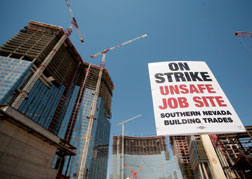Every day, craft workers with sun-baked faces and calloused hands ready themselves for another shift of construction on the Las Vegas Strip, trading jokes before toting their plastic coolers onto the site. The favorite uniform is a short-sleeved cotton T-shirt suited to the 100°-plus temperatures.
 AP/Wideworld String of fatalities led to walkout by union workers at Las Vegas projects.
|
The workers face hazards even more dangerous than the sun, and over the past two years, 13 never made it home. One was Dustin “Doobie” Tarter, 39, who was crushed by a crane counterweight system at the CityCenter project on May 31. An affable, fun-loving man, Tarter’s death unlocked pent-up resentment over the accidents, and 100 union workers began picketing CityCenter and the nearby Cosmopolitan jobsites and chanting, “No more death.”
Within a day, the key contractor at CityCenter, Perini Corp., agreed with the Southern Nevada Building and Construction Trades Council that all workers would receive the 10-hour federal safety training and be sent to additional safety meetings. Also, union officials and safety directors would gain full jobsite access. Most or all of what was agreed to already had been discussed or agreed to by the contractor and the unions.
|
The bigger question is, Why did it take so long to ratchet up safety? The 13 construction-related fatalities on the Las Vegas Strip are more than the city saw during the entire 1990s building boom. But in the last two years there was a difference. Resort owners and their contractors were building on a vast scale, gathering thousands of disparate craft workers in the cauldron of the Nevada desert, then hurrying them to complete the work to meet ambitious schedules with inadequate regard to fatigue. The owners never stressed safety as much as schedule, and the contractors failed to scale up the safety effort to the level of the construction boom. Even today, 5,000 workers at CityCenter have not received the federal 10-hour safety training, says Pete Stafford, executive director of the union-funded Center for Construction Research and Training. While such training is not mandatory, it is hard to tell who has had a sufficient level of safety training or none.
 Guy Lawrence / ENR
|
| “This level and complexity of construction is unprecedented.” —GREG MCCLELLAND, SAFETY DIRECTOR, IRONWORKERS COMPENSATION TRUST
|
Nevada, which has a state-operated safety agency, also failed to keep pace with the boom by not adding staff, and the agency often reduced its safety fines from those initially proposed to a mere financial blip. The $9.2-billion, 76-acre CityCenter complex will be bigger than Rockefeller Center and Times Square combined. Developer MGM Mirage Inc. says it is the largest privately financed project in U.S. history. Workers gave the site their own grim nickname: CityCemetary.
In prior decades, casino operators built one megaresort at a time, with additional towers coming in separate, stand-alone phases. Today’s projects, like CityCenter and the $4.8-billion, 12-million-sq-ft Echelon, under construction further north on the Strip, are different. Rising raw-material prices, competition for skilled workers, financing costs and the push to create the next must-see extravaganza have led to much more simultaneous construction. And expensive real estate means that sixty-story towers now rise where 20-stories would have sufficed in prior decades.
“This level and complexity of construction is unprecedented,” says Greg McClelland, safety director for the Ironworkers Compensation Trust.
Local building trade unions have ramped-up apprenticeship programs and recruited heavily from out of state, waiving local fees and transferring pension and health benefits, in order to attract the workers needed to staff megaprojects. Laborers’ union Local 872 has doubled to 3,500 members, including 200 floaters, working on The Strip. Union officials worry that workers from the Midwest, Rust Belt and East Coast lack or exaggerate their experience.
“Many are coming from the Midwest where they would never have an opportunity to work on a project of this magnitude,” says Las Vegas Councilman Steven D. Ross, secretary-treasurer of the Southern Nevada Building and Construction Trades Council. “We’re trying to bring everyone up to a higher standard.”
With sweltering daytime heat creating danger of dehydration and nights that are anything but dry, the city itself is a hazard. “It takes a certain discipline to work in Las Vegas,” says McClelland. “We have workers making $2,000 a week in a town where the bars never close. Several companies have men walking the jobsite looking for guys with that thousand-yard stare. If they’ve been up too late, we’ll send them home.”
How many workers are hurt because of drug and alcohol use is not clear. Although all employees are tested before hiring, CityCenter, for example, has no random-testing program. Unions consider it an invasion of privacy, but employers say they want it and think it would help.
Overdoing Overtime
 Las Vegas News Bureau
|
Workers are often their own worst enemies, wearing themselves down with additional hours for lucrative overtime pay. The hours are readily available for those willing to push themselves longer and harder. Tight economic times have created many volunteers eagerly seeking “double-backs,” or back-to-back work shifts, for extra income. Workers, in some instances, say they try to make up the difference for lost income of a recently laid-off spouse or significant other.
“It’s like a drip-line to a junkie,” says Joe Taylor, executive director of the Southern Nevada Laborers-Employers Cooperation and Education Trust. “It raises the standard of living with overtime, and they soon become focused on the money.”
| Lives Lost On The Strip |
| 2006 |
| December 5 Isidro “Willie” Pelayo, 39, Laborer Foreman Trump International Hotel & Tower Las Vegas General Contractor: Perini Building Co. Thrown from malfunctioning buggy into elevator shaft. |
| 2007 |
| February 6 Bobby Lee Tohannie, 44, Carpenter CityCenter General Contractor: Perini Building Co. Crushed inside elevator shaft when concrete form collapsed. Angel Hernandez, 24, Carpenter CityCenter General Contractor: Perini Building Co. Crushed inside elevator shaft when concrete form collapsed. |
| August 2 Norvin Tsosie, 36, Ironworker (Apprentice) Fontainebleau Las Vegas General Contractor: Turnberry West Construction Subcontractor: Nevada Prefab Engineers Fell following cable-support-system failure. |
| August 9 Harvey Englander, 65, Operating Engineer CityCenter General Contractor: Perini Building Co. Fell after being struck by descending man-lift counterweight. |
| August 17 Justin Paul Chapman, 31, Concrete Cutter Palms Place Tower General Contractor: M.J. Dean Construction Fell down elevator shaft after striking head on beam. |
| October 5 Harold “Rusty” Billingsley, 46, Ironworker CityCenter General Contractor: Perini Building Co. Subcontractor: SME Steel Contractors Fell through opening in floor decking. |
| November 26 Michael Hanson, 42, Laborer The Palazzo Resort Hotel Casino General Contractor: Taylor International Corp. Struck in head by piece of concrete slab raised by forklift. |
| November 27 David Rabun, Jr., 30, Ironworker Apprentice Cosmopolitan Resort & Casino General Contractor: Perini Building Co. Subcontractor: Schuff Steel Fell after I-beam spreader broke free from wall. |
| 2008 |
| January 14 Michael Taylor, 58, Safety Engineer Cosmopolitan Resort & Casino General Contractor: Perini Building Co. Subcontractor: Reliable Steel Fell after guardrail corner support collapsed. |
| April 26 Mark Wescoat, 47, Electrician CityCenter General Contractor: Perini Building Co. Subcontractor: Fisk Electric Co. Fell about 25 ft. |
| May 31 Dustin Tarter, 39, Operating Engineer CityCenter General Contractor: Perini Building Co. Subcontractor: Dielco Crane Co. Crushed while oiling crane-counterweight system. |
| June 17 Lyndall Bates, 49, Carpenter Echelon Las Vegas Construction Manager: Tishman Construction Corp. Subcontractor: Marnell Corrao Associates Fell after mistakenly dismantling scaffolding piece to which he was tied off. |
A number of the deaths occurred during early-morning hours, when workers may not be fully alert or are rushing to finish a nighttime shift, sources point out. Did fatigue help kill Lyndall Bates? He was a 49-year-old carpenter who died on June 17 at the Echelon project while disassembling a piece of scaffolding to which he was tied off. He struck his head in a 15-ft fall at 7:20 a.m.
“Productivity rates are different here than other parts of the country,” says one longtime Las Vegas contractor who asked not to be identified. “We work...
 Related Links:
Related Links: 

Post a comment to this article
Report Abusive Comment